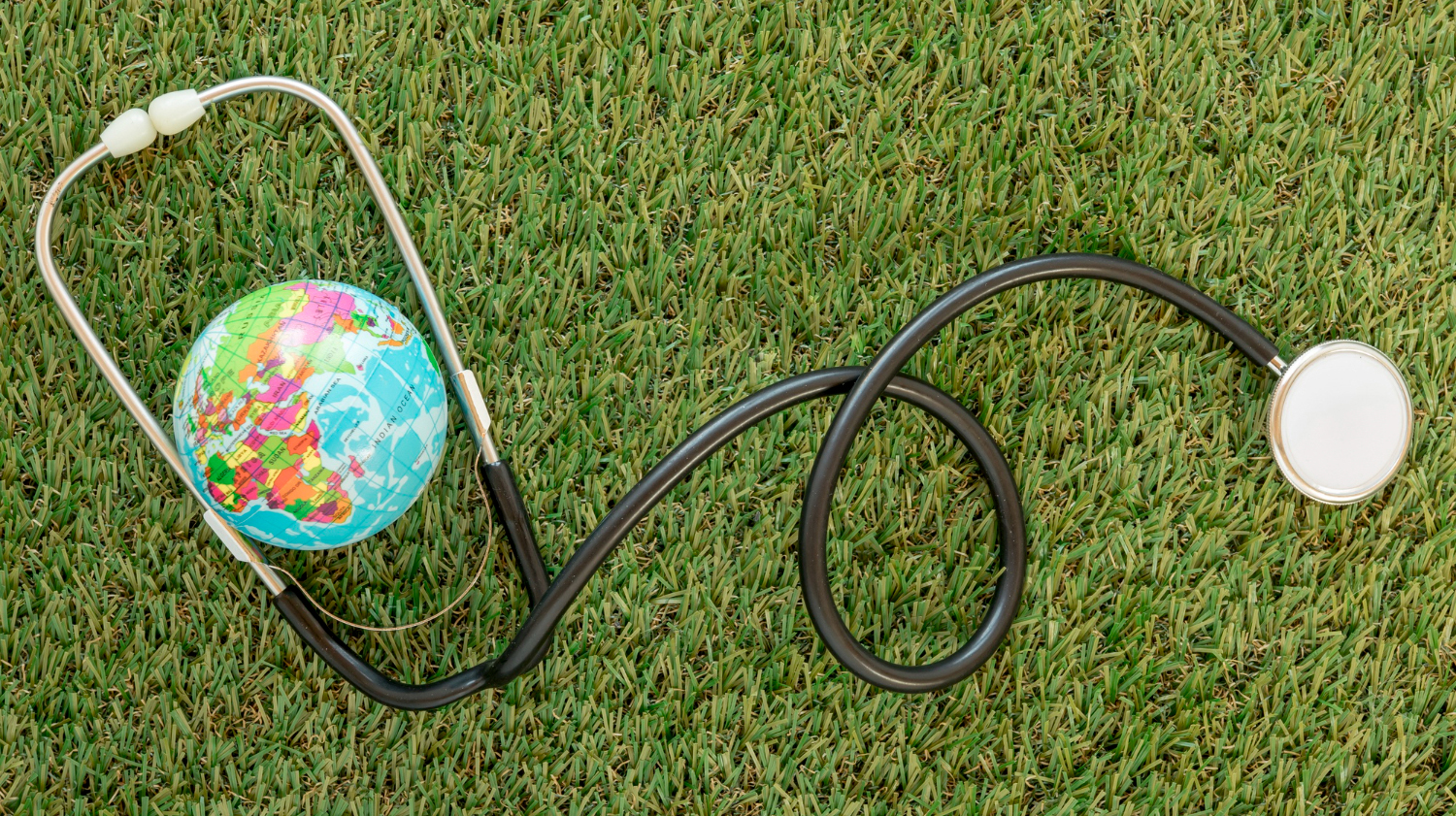
Blog
Leading the Way in Sustainable Healthcare Systems
In recent years, the imperative for sustainability has risen in every industry on a global discourse. At first glance, it may seem that healthcare does not have a significant impact on environmental problems, but in fact, it does not. If healthcare systems aren't designed with the planet in mind, they can contribute to making us sick.
As populations expand, resources decline while environmental concerns mount, ensuring efficiency has become paramount. In this landscape of the climate crisis, protecting human health is a matter of protecting the planet. It is possible to enhance human health with this sustainable approach based on respect for the planet and future generations.
Moreover, especially during the pandemic, long-standing inequalities in access to healthcare got more attention. Insufficient healthcare access is a pain to the whole society and economy. Healthcare authorities have to improve more sustainable and equitable services.
On the other hand, the desire for sustainability in healthcare is a tough challenge due to the large gap between intention and tangible actions. Creating a sustainable shift requires a long-term and systematic investment to shape a future where an eco-friendly healthcare system is more accessible.
There is a way to realize sustainable healthcare innovation globally, like the approach we employ as the Tiga Healthcare Technologies team. We sustainably execute our commitment to advancing human-centered healthcare solutions. In this blog, we aim to explain the foundations of sustainable healthcare, giving examples from our products and structures. Before our successful journey, we need to see why sustainable healthcare matters and basic standpoints.

Why do Sustainable Healthcare Innovations Matter?
It's ironic that the healthcare system, intended to advance human health, stands as an environmental pollutant. What's imperative is a sustainable shift towards creating health systems that are both environmentally friendly and accessible, with a focus on the needs of future generations and the planet. For example, hospitals and healthcare facilities can have green building designs with sustainable materials and energy-efficient technologies like solar panels or green roofs, partially or completely covered with vegetation.
Additionally, these innovations involve minimizing the healthcare system's environmental footprint while supporting patient-centric care with remote monitoring options through more engagement and fewer physical visits. Another example is for reducing waste reduction by implementing recycling programs especially medical equipment of clinical processes and hazardous materials.
Ultimately, sustainable innovations lead to energy-efficient methods from the research stage onward and reduce environmental impact with more precise, goal-oriented and practical functioning healthcare systems.
In this landscape, decision-makers realize that they have an ethical responsibility to transform healthcare in favor of sustainability. For a significant example, the Cop28 Climate Change Conference released the first health-centered climate action declaration in 2023 for sustainable healthcare design. Now, it is time to turn our attention to the key supporting points in detail with reports and specific examples.

Environmental Responsibility
For healthcare systems to improve health in all aspects, environmental problems must be systematically addressed. According to data from the 2022 Lancet Countdown Report, the healthcare industry is accountable for 5.2% of global emissions, damaging health in several ways such as water pollutants. The report highlights that an important source of emissions is the supply chain involved in drug production and distribution. Furthermore, repeated inaccurate tests and diagnostic imaging methods like MRI and CT result in a waste of energy. Then, what could be a solution?
For the delivery of net zero health systems, health authorities holistically manage these axles with interoperable solutions:
- Healthcare supply chain: Prevention of wasteful practices, digital traceability, avoidance of duplicate procedures to stop drug fraud and counterfeiting
- Patient care ways: Paperless procedures of entire clinical services, reusable clinical items, digital traceability
- Clinical research: Energy-efficient equipment, optimized resource usage, digital traceability, AI-based solutions
These three areas play a crucial role in curbing the carbon emissions of healthcare systems, and the examples provided for each offer practical strategies for implementation. To achieve sustainable results, tracking and integration of healthcare supply chain, patient care ways and clinical research should be seamless. Thus, health professionals can avoid harmful cycles of data loss and inaccurate testing, preventing misdiagnoses and enabling clinical research to operate more efficiently with reduced energy consumption, while suppliers ensure proper medication distribution.
For instance, AI-based tools may help hospitals with accurate readings on scans in seconds. Eventually, most of the repetitive processes may be eliminated.
Access to Quality Care
Sustainability has one other pillar, societal. Let's delve into the social sustainability healthcare principle: prioritizing quality care through accessible means. As the pandemic showed recently, global commitment to sustainability extends to a fair society where healthcare services for everyone with healthcare IT products.
With digitalization, the healthcare industry can create a harmonic ecosystem. Healthcare facilities should set digital models based on social justice alongside environmental responsibility. For instance, centralized digital systems and healthcare IT products enhance patient engagement while ensuring greater accessibility to the whole society. For example, the Personal Health Record (PHR) system we developed as Tiga, provides 24/7 access to all patients' health records, enabling patients to control and manage. Thus, patient engagement in the healthcare system increases and contributes to a more sustainable system.
Promoting Patient-Centricity
To gain a greener and sustainable healthcare approach is to be patient-centered. By optimizing resource allocation, patient-centricity can improve long-term health outcomes by prioritizing patients' needs and preferences. Also, it can lead to reduced waste and environmental impact.
Beyond these, the active participation of patients in their care and treatment plans drives innovation with their feedback, leading to the development of more effective and sustainable healthcare solutions.
As Tiga, we are aware of our responsibility to do our best to provide trusted healthcare IT products based on paperless processes and remote monitoring. It's time to get to know our sustainability processes more closely.
![]()
Our Approach to Sustainability
We recognize our duty to defend sustainability with trustworthy healthcare IT products. It's imperative to explore our processes to show that we are meeting our human-centricity in healthcare IT principles in a sustainable manner. Let's take the opportunity to gain an understanding of how we integrate sustainability into our products and even our office with green building design. First, we will review our system and projects, followed by an examination of our e-health approach and products.
Paperless Projects
Moving towards paperless digital systems represents a stride not only in efficiency and cost reduction but also in environmental responsibility and patient care enhancement. With seamless data integrations, digital records enable easy sharing across departments, ensuring immediate access to patient information. This transition indicates a paradigm shift by substantially reducing carbon footprint.
All of our solutions empower healthcare providers to transition away from paper-based documentation, leading to streamlined workflows with accurate record-keeping, ultimately contributing to sustainable healthcare practices.
Sustainability Governance
We have procedures for complying with quality standards to promote patient safety. We also hold a certificate to deal with ISO 14001, an Environmental Management System (EMS) standard that provides a systematic approach to dealing with environmental impacts. ISO 14001 ensures that environmental considerations are integrated into its decision-making processes and ultimately business strategy. We embrace this standard to enhance our environmental responsibilities.
Growing Together: Organic Garden Initiative
Cultivating an organic garden within our headquarters premises is a satisfying endeavor rooted in eco-friendliness. The establishment of our organic garden serves a dual purpose: creating a space for individuals to reconnect with nature and fostering the growth of fresh produce, all while fostering a sustainable environment. This initiative embodies our commitment to promoting environmental consciousness and sustainable practices.
By offering this organic ecosystem, we prioritize not only the well-being of our employees but also the sustainability of our environment. Recognizing the interconnectedness between human health and environmental health, we aim to cultivate a workplace that nurtures personal growth, while contributing positively to the broader ecosystem.
Important Examples of Tiga Healthcare Solutions
As Tiga, our mission extends beyond merely digitalizing health practices; we aim to both centralize and personalize healthcare solutions systematically with a structure that can adapt to changing conditions. We are committed to pursuing sustainable healthcare innovation by respecting the environment with an integrated strategy that especially minimizes the medical supply chain and patient care’s harmful effects.
Our systems are designed to continuously evolve and be responsive to emerging needs. Let's explore some product examples that exemplify our dedication to sustainability.

Personal Health Records (PHR)
Emphasizing the importance of obtaining accurate results is paramount for sustainability in any project. Through initiatives like Personal Health Records (PHR), we enable physicians to access patient data in real-time, freeing up valuable time for direct patient care while. This way, administrative burdens and paperwork are minimized, as are waste and energy loss. Also, the number of repetitive tests and hospital visits of patients is reduced, thus carbon emissions during their hospital travels are reduced.
Moreover, empowering patients with control over their health records fosters greater engagement and accountability, contributing to sustainable healthcare outcomes by promoting proactivity and collaboration, while diminishing the environmental effects.
Healthcare Interoperability Products
Our comprehensive roadmap for healthcare interoperability underscores our commitment to sustainability on multiple fronts. By enabling diverse IT systems, devices and applications to seamlessly access, exchange and integrate data securely, we promote efficiency in healthcare delivery by eliminating paperwork. Through this interoperability, we can incorporate essential components aligned with our core offerings, reinforcing our dedication to transforming patient care and driving accurate clinical outcomes.
After all, sustainability is about integrity and adaptation. By implementing sustainable practices in healthcare, such as optimizing diagnosis methods with energy efficiency and increasing patient involvement, we can enhance health outcomes while reducing redundant tasks that are harmful to the environment. For another example, our e-Pharmacy system handles the necessary controls at the pharmacy level in the dispensing process with digital control.
This strategy not only adheres to sustainable principles but also ensures the enduring viability and adaptability of healthcare systems in addressing evolving demands and obstacles.
Drug Traceability
The discussion on the role of supply chain tracking for net-zero systems highlights the significance of products like the Pharmaceutical Track & Trace System, branded as DrugXafe, in ensuring sustainability. Designed to enhance drug safety and prevent counterfeiting, this system offers comprehensive traceability throughout the supply chain, from production to end-user.
With electronic product codes, the system ensures transparency and accountability, guaranteeing a clean and error-minimized supply chain. By optimizing logistic processes, greenhouse gas is reduced, and the resale and counterfeit production of drugs are prevented. This not only safeguards the integrity of pharmaceutical products but also contributes to sustainable practices by promoting efficiency, reliability and trust.

Future Innovations
As we look to the future of healthcare, we see nothing but sustainability. From pioneering healthcare technology products to revolutionizing clinical care with AI-driven projects, our role is to push the boundaries of what's possible, trying to set new standards. Our efforts in bringing more sustainable solutions have found their purpose; we integrate them into every aspect of our patient-centered operations.
We drew inspiration from the sustainable healthcare actions of other individuals and groups, while also recognizing our responsibility to inspire additional organizations to join the good cause. By working together towards a common goal for sustainability, we can create a healthcare system that not only meets the needs of the present but also saves the well-being of future generations. Let’s shape the future together for a more secure and interoperable tomorrow!









